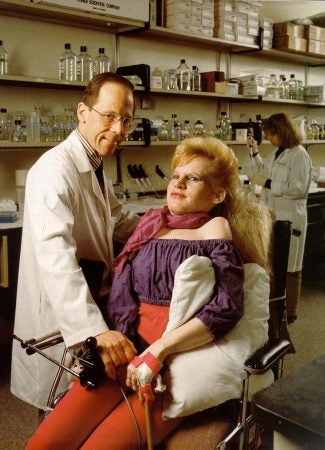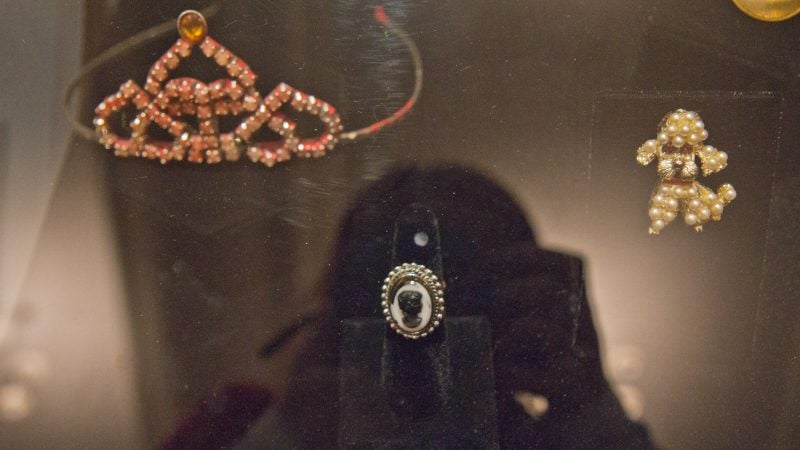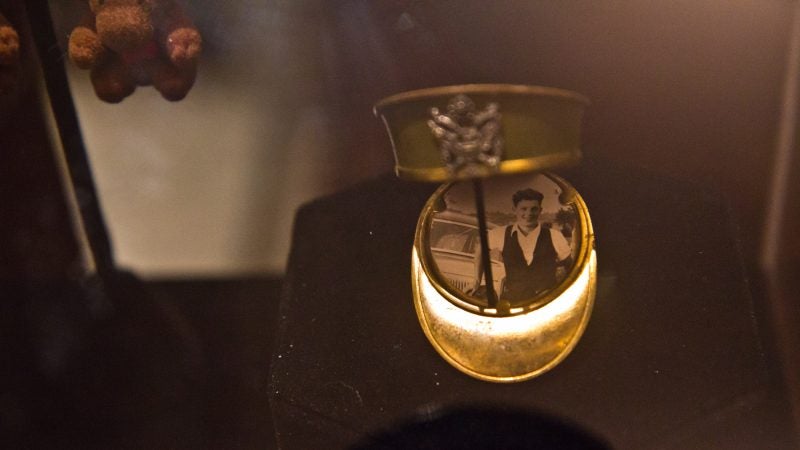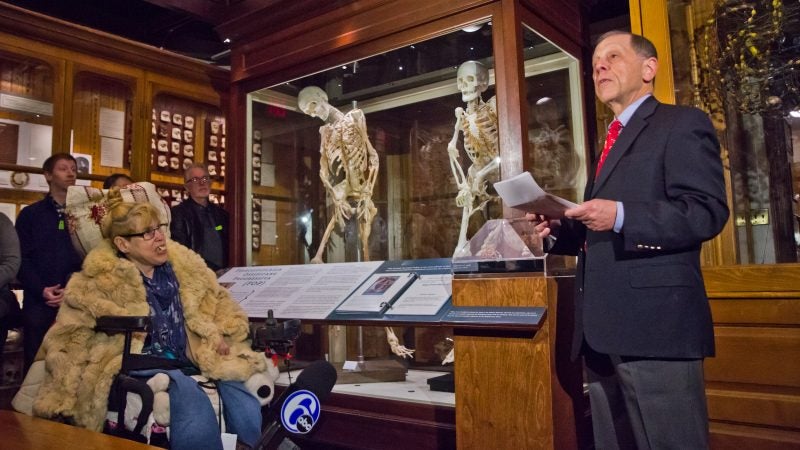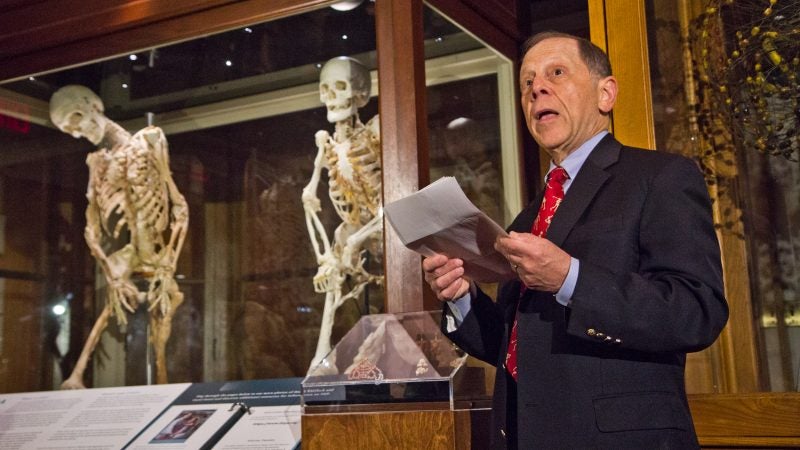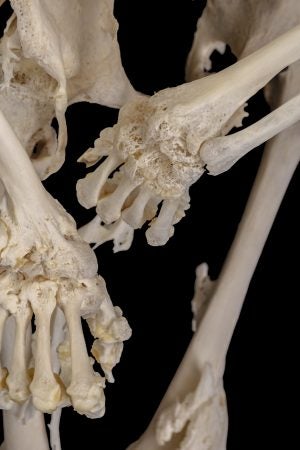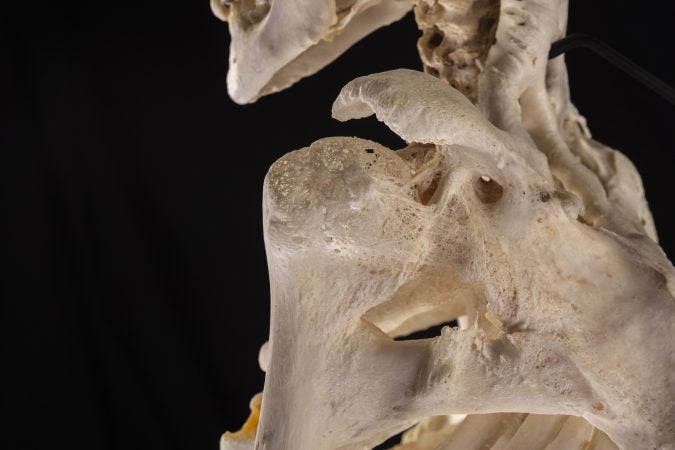Philly woman with rare bone disease donates skeleton to Mütter Museum
The bequest was Carol Orzel’s dying wish, so that others could learn more about her rare disease, fibrodysplasia ossificans progressiva.

Carol Orzel had FOP, a rare disorder in which connective tissue is replaced by bone. She wished her skeleton to be displayed at the Mütter Museum in Philadelphia. (Kimberly Paynter/WHYY)
From the moment Carol Orzel met Harry Eastlack in 1995, she was enchanted. They didn’t come face to face — by then, Eastlack had been dead for 22 years.
Instead, Orzel met his skeleton at a gathering for families of people with fibrodysplasia ossificans progressiva, also known as FOP, a rare bone disease that Orzel and Eastlack shared.
Eastlack’s skeleton had been on display since 1979 at Philadelphia’s Mütter Museum. The museum had lent the skeleton for the gathering to help families better understand the disease, which causes bone to grow in soft tissue throughout the body.
At that event, Orzel turned to her doctor, Frederick Kaplan of the University of Pennsylvania, and said, “When my time comes, I would like to hang next to Harry at the Mütter Museum.”
“And then,” Kaplan remembered, “she looked at me with her usual smile and a glimmer in her eye and said, ‘Only if my jewelry can be displayed there too.’ ”
Orzel died in February 2018 at age 58, and this week, she got her wish. Her skeleton, along with a collection of tiaras, earrings and brooches from her extensive costume-jewelry collection, is on display at the Mütter, along with information about the course of her condition and its effects.
FOP is one of the rarest diseases in the world. Only about 900 people have been diagnosed with it. The mutation of a single nucleobase out of 6 million in a person’s DNA causes ribbons, plates and sheets of bone to cross the joints and lock them up, making movement impossible.
At birth, the only visible sign of FOP is what looks like a bunion in the big toe; it is, in fact, a malformation of the joint. Between the ages of 2 and 5, painful swellings that look like tumors begin to emerge on the neck and back and then slowly transform into bone. Any attempt to remove bone can cause a joint to lock permanently, as can immunizations or other injections.
“It’s normal bone,” said Kaplan, who treated Orzel for more than 30 years. “It just shouldn’t be there. It’s an example of too much of a good thing.”
As the disease progresses, it affects the upper limbs, then the lower limbs in adolescence, and eventually in adulthood it affects the jaw, elbows, knees, and wrists. By the time patients reach their 40s, very little if any mobility is left.
In her later years, Orzel had only some mobility left in her wrists and fingers.
Bone doesn’t form within organs, but because of the constrictions of bone around the chest wall, it makes it hard for the chest to expand.
“So the heart has to pump for a lifetime against a chest that doesn’t expand,” Kaplan said, “and eventually the heart gets tired.”
Most patients succumb to heart and lung problems, and that was the case with Orzel.
A need for speed
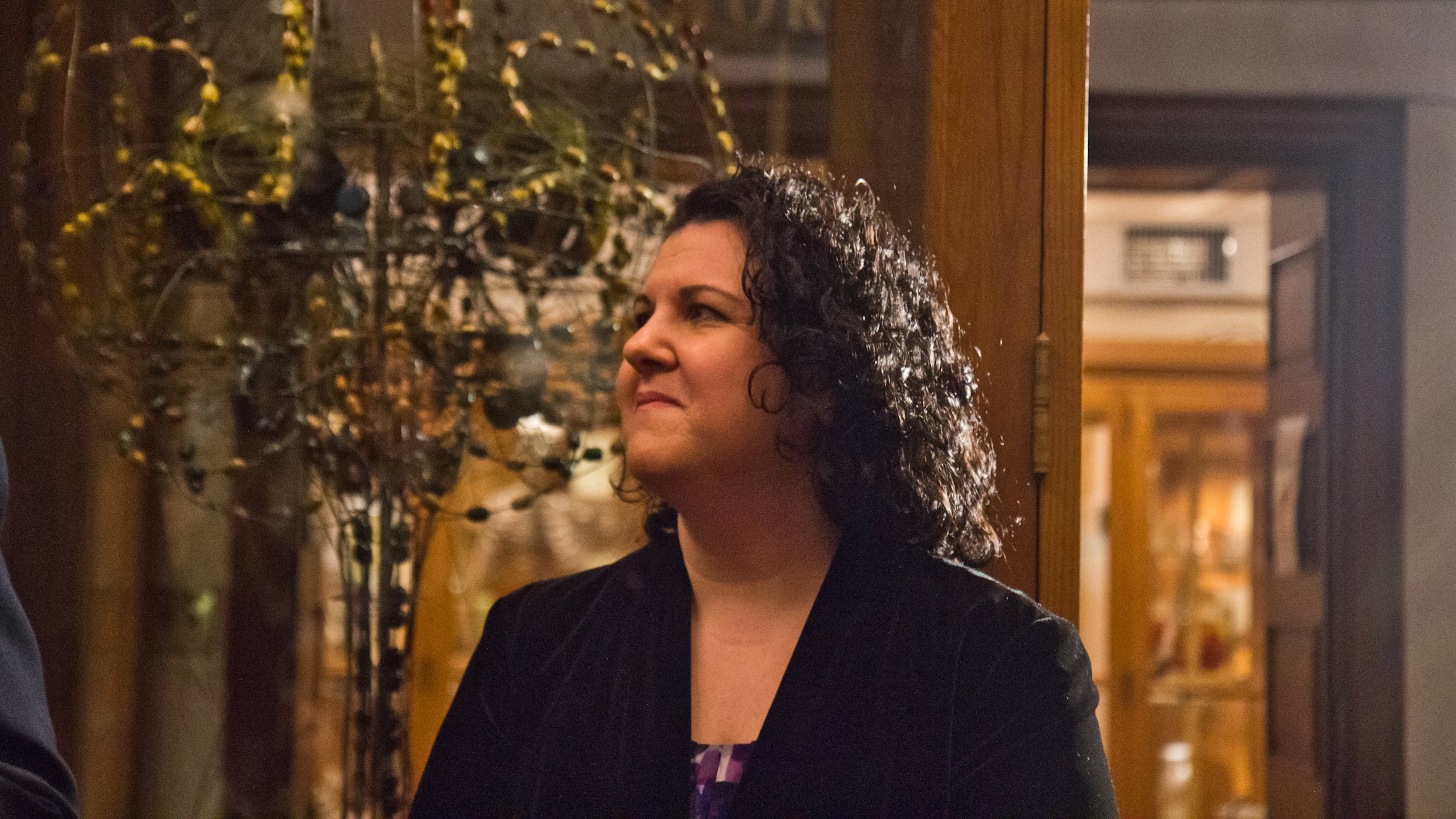
When she died, the museum was in a race against time. It had a matter of days to transport and transform the body into a skeleton.
“Carol is fully fused, so her body couldn’t be disarticulated first and rendered into a skeleton, and then rearticulated,” said Mütter Museum curator Anna Dhody. “She is one unit.”
The only place in the country that was able to take on the task was Skulls Unlimited, which traditionally deals with animal skeletons of the type on display in a natural-history museum. But that company is based in Oklahoma, so the museum had to factor in transportation, paperwork, and logistics, along with a special case to transport the body.
“I can’t articulate how delicate her bone is,” Dhody said. “It was almost like taking cotton candy and hairspray.”
Aside from FOP, which caused bone to grow where it shouldn’t, Orzel also dealt with the bone loss that afflicts many women in their 50s, so some of her bone was nearly translucent. It was even more fragile when the skeleton was transported back to the museum. Skulls Unlimited provided a white-glove service, with a custom padded crate. Orzel’s skeleton was driven all the way from Oklahoma to the museum in Philadelphia, where it was stored until a new case and exhibit space was completed to display it with Eastlack’s.
With about 180,000 visitors to the museum each year, Dhody hopes exhibiting both skeletons will broaden public knowledge and understanding of the disease.
“She’s going to be able to impact a much broader and much greater number of people to learn about the condition,” Dhody said. “We want to explain that the more we know about how bone grows where it’s not supposed to grow, it can help a wider variety of people than just the 900 people with FOP.”
A passion for education … and Philly
According to Kaplan, educating people about FOP was Orzel’s great joy. Every year, she gave a lecture to students in the genetics course at the Perelman School of Medicine and would describe the human side of the disease.
Kaplan said Orzel understood that conditions such as hers could impart other lessons too: “There’s no better way to display the mysteries of the human body than with rare diseases.”
He and his Penn colleague Eileen Shore discovered the gene that causes FOP in 2006. That gene also has a part in the bone-formation processes that involve healing fractures and other conditions that affect the skeleton, such as spinal cord injuries, head injuries, and war wounds.
“Although FOP is an exceptionally ultra-rare disease, the lessons of FOP are relevant to every condition that affects the formation of the skeleton,” Kaplan said.
“It’s the rare diseases that reveal the genes and the molecular pathways that the body uses for common diseases as well, and those genes and pathways become the targets for drugs not just for the rare diseases, but for the common diseases that use those same roads. So the key to the closet is really the key to the kingdom.”
As much as Orzel had a passion for education, she also had a passion for Philadelphia, where she lived all her life, much of it at Inglis House, the 143-year-old long-term care community for people with physical disabilities.
She loved Tastykakes, and regularly visited the city’s cultural attractions, from galleries and museums to concerts. “She probably visited more places in Philadelphia and did more things than I did,” Kaplan said.
She found ways around her disability, seeking out tools to apply makeup before a night on the town.
Dhody said Orzel’s love of the city and commitment to scientific research make the Mütter Museum a perfect final resting place for her.
“I love that she’s a Philly girl, and I love that she’s staying in Philadelphia,” Dhody said.
WHYY is your source for fact-based, in-depth journalism and information. As a nonprofit organization, we rely on financial support from readers like you. Please give today.


